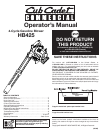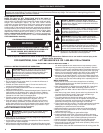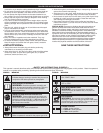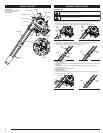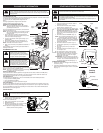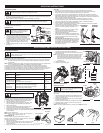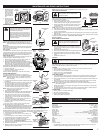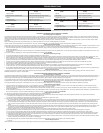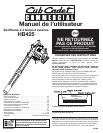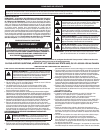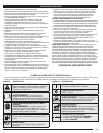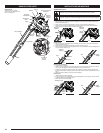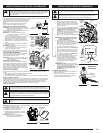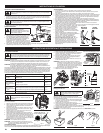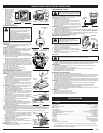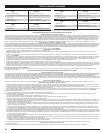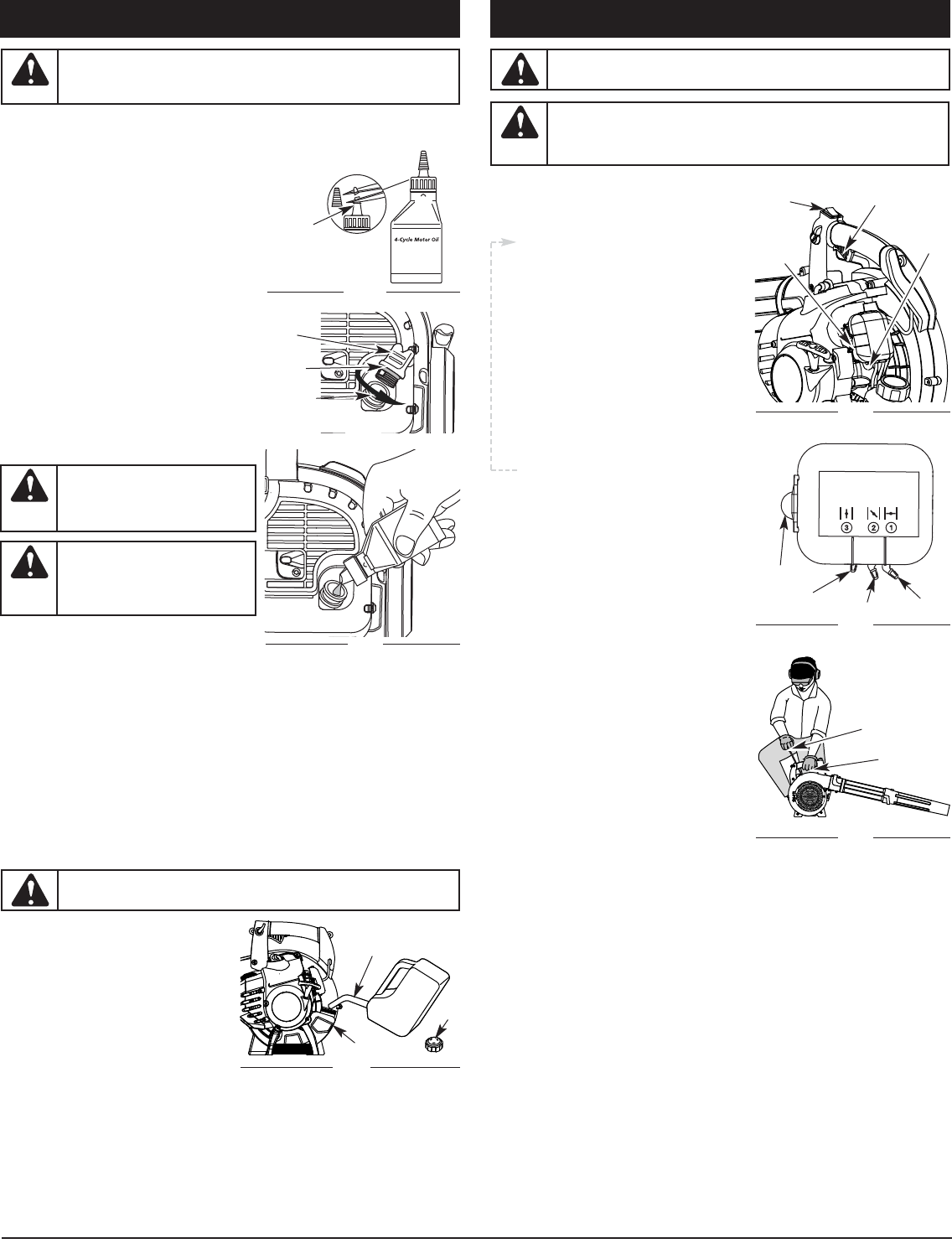
5
OIL AND FUEL INFORMATION
RECOMMENDED OIL TYPE
Using the proper type and weight of oil in the crankcase is extremely important. Check the oil before each
use and change the oil regularly. Failure to use the correct oil,
or using dirty oil, can cause premature engine wear and
failure.
Use a high-quality SAE 30 weight oil of API (American
Petroleum Institute) service class SF, SG, SH.
ADDING OIL TO CRANKCASE: INITIAL USE
NOTE: This unit is shipped without oil. In order to avoid
damage to the unit, put oil in the crankcase before
you attempt to start the unit.
Your unit is supplied with one 2.03 fluid oz. (60 ml.) bottle of
SAE 30 SF, SG, SH oil (Fig. 7).
NOTE: Save the empty oil bottle. It can be used to measure
the correct amount during future oil changes. See
Changing the Oil.
1. Unscrew the top of the bottle of oil and remove the
paper seal covering the opening. Replace the top. Next,
cut the tip off the funnel spout (Fig. 7).
2. Tip unit so that the back of the engine is facing up in a
vertical position.
3. Remove the oil fill plug from the crankcase (Fig. 8).
4. Pour the entire bottle of oil into the oil fill hole (Fig. 9).
NOTE: Never add oil to the fuel or fuel tank.
5. Wipe up any oil that may have spilled and reinstall the oil
fill plug.
Check oil before each use and change as needed. Refer to
Checking the Oil Level.
RECOMMENDED FUEL TYPE
Old fuel is the primary reason for improper unit performance.
Be sure to use fresh, clean, unleaded gasoline.
NOTE: This is a four cycle engine. In order to avoid damage
to the unit, do not mix oil with gasoline.
Definition of Blended Fuels
Today's fuels are often a blend of gasoline and oxygenates such as ethanol, methanol or MTBE (ether).
Alcohol-blended fuel absorbs water. As little as 1% water in the fuel can form acids when stored. Use
fresh fuel (less than 60 days old), when using alcohol-blended fuel.
Using Blended Fuels
If you choose to use a blended fuel, or its use is unavoidable, follow recommended precautions:
• Always use fresh unleaded gasoline
• Use a gas stabilizer fuel additive
• Drain tank and run the engine dry before storing unit
Using Fuel Additives
The use of a gas stabilizer will inhibit corrosion and minimize the formation of gum deposits. Using a fuel
additive can keep fuel from forming harmful deposits in the carburetor for up to six (6) months. Add 0.8 oz.
(23 ml.) of fuel additive per gallon of fuel according to the instructions on the container. NEVER add fuel
additives directly to the unit's gas tank.
Fig. 7
Funnel
Spout
Oil Fill Plug
Oil Fill
Hole
O-Ring
Fig. 8
Fig. 9
FUELING THE UNIT
1. Remove the fuel cap (Fig. 10).
2. Place the gas container’s spout into the fill hole on
the fuel tank (Fig. 10) and fill the tank.
NOTE: Do not overfill the tank.
3. Wipe up any gasoline that may have spilled.
4. Reinstall the fuel cap.
5. Move the unit at least 30 ft. (9.1 m) from the fueling
source and site before starting the engine.
NOTE: Dispose of the old gasoline in accordance to
Federal, State and Local regulations.
Fig. 10
Fuel
Cap
Fuel Tank
Gas Can
Spout
STARTING/STOPPING INSTRUCTIONS
STARTING INSTRUCTIONS
STOPPING INSTRUCTIONS
1. Release your hand from the trigger. Allow the engine to
cool down by idling.
2. Press the On/Off Stop Control switch in the OFF (O)
position and hold until the engine comes to a complete
stop (Fig. 11).
1. Check the oil level in the crankcase. Refer to
Checking the Oil Level.
2. Fill the fuel tank with fresh, clean unleaded
gasoline. Refer to Fueling the Unit.
3. Fully press and release the primer bulb 10 times,
slowly. Some amount of fuel should be visible in
the primer bulb and fuel lines (Fig. 11). If you
can’t see fuel in the bulb, press and release the
bulb as many times as it takes before you can
see fuel in it.
4. Place the choke lever in Position 1 (Fig. 12).
NOTE: The unit should be started in idle. Do not
squeeze the trigger while starting (Fig. 13).
5. Crouch in the starting position (Fig. 13) and pull
the starter rope out until you feel some resistance.
This is usually around 2–4 inches. Pull 4 times in
smooth and rapid pulls.
6. Place the choke lever in Position 2 (Fig. 12).
7. Pull the starter rope briskly 1 to 4 times to start
the engine.
8. Allow the engine to warm up for 30 to 60
seconds.
9. Place the choke lever in Position 3 (Fig. 12). The
unit is ready for use.
IF... the engine does not start, go back to step 3.
IF... the engine fails to start after a few attempts,
place the choke lever in Position 3 and pull the
starter rope briskly 3 to 8 times. The engine
should start. If not, repeat.
HOT RESTART: If the unit is already hot, place the
choke lever in Position 3 and pull the starter rope
to restart. The unit should be started in idle. Do
not squeeze the trigger while starting (Fig. 11).
Fig. 11
Choke
Lever
Primer
Bulb
On/Off
Trigger
Fig. 12
Fig. 13
Primer Bulb
Position 1
Position 2
Position 3
Starting
Position
Starter Rope
Throttle Control
WARNING: Remove fuel cap slowly to avoid injury from fuel spray. Never operate
the unit without the fuel cap securely in place.
WARNING:
Gasoline is extremely
flammable. Ignited vapors may explode.
Always stop the engine and allow it to cool
before filling the fuel tank. Do not smoke
while filling the tank. Keep sparks and
open flames at a distance from the area.
WARNING: Add fuel in a clean, well
ventilated outdoor area. Wipe up any
spilled fuel immediately. Avoid creating a
source of ignition for spilt fuel. Do not start
the engine until fuel vapors dissipate.
WARNING: OVERFILLING OIL CRANKCASE MAY CAUSE SERIOUS PERSONAL
INJURY. Check and maintain the proper oil level in the crank case; it is important and
cannot be overemphasized. Check the oil before each use and change it as needed. See
Changing the Oil.
WARNING: Avoid accidental starting. Make sure you are in the starting position
when pulling the starter rope (Fig. 13). To avoid serious injury, the operator and unit must
be in a stable position while starting.
To avoid serious personal injury, make sure that the blower tube is locked in place or
firmly installed.
WARNING: Operate this unit only in a well-ventilated outdoor area. Carbon
monoxide exhaust fumes can be lethal in a confined area.



